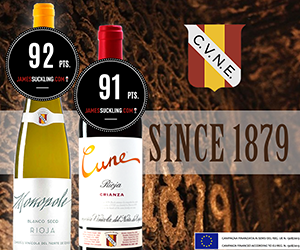The death of Cellared in Canada or (CiC) wines was a long time coming.
After grabbing hundreds of millions of dollars in income for producers while causing even more damage to the image of Canadian wine, the wine that never had anything to do with authentic Canadian wine will no longer be able to use the highly deceptive, and frankly fraudulent Cellared in Canada phrase, on its label. The concept was spawned during the original NAFTA agreements when Canadian wineries, read the large commercial producers, complained that levelling the tax playing field would put them out of business. They negotiated a number of temporary agreements in 1994 (CiC was one of them) to soften the blow and, as it turns out, prevent the field from ever being levelled. Nearly a quarter centry later the temprary agreement establishing the CiC category has been killed by the Canadian Food Inspection Agency (CFIA)
Beginning April 1, no fooling, blended wines bottled in Canada from both domestic and international product will be required by the CFIA to replace “Cellared in Canada” with two possible monikers. For primarily imported wines it will be labelled as “International blend from imported and domestic wines.” For primarily domestic wines, it will be labelled as “International blend from domestic and imported wines.”
A lot of the same people who tacitly approved of CiC wines and looked sideways whenever the subject was brought up are now front and center taking bows for the new rules and for saving the future of Canadian wine. Oddly many of the same folks are responsible for blocking the distribution of Canadian wine across the country, but that’s another story, and another fight.
Now that Canadian wine has been differentiated from cheap off-shore juice that arrives below the water line of huge tankers, maybe we could get on with some meaningful national wine laws that authenticate the origin of every wine made in Canada based on a single national system. There is so much to do and we have wasted so much time and energy on the CiC issue; it’s time to turn the page and tell the story of real Canadian wine.
Here is some background on the final changes that were spearheaded from a group of British Columbia wine producers that first appeared online at WineAlign in early 2017.
FINAL BLEND
If the world needs more Canada, we are ready.
by Anthony Gismondi
There were some big Canadian wine stories in 2016 and many have been chronicled on this site by my colleague David Lawrason in his regular look at Canadian wine. The biggest story of 2016 has yet to be announced however as we spill into 2017. It seems there may be a resolution to the ongoing issue of bottling foreign juice, with or without adding Canadian content, and selling those bottles with some reference to Canada on the label. After decades of discontent the wine category infamously known as the Cellared in Canada (CiC) and since renamed International Canadian Blended (ICB) is about to get a new name.
Any decision to finally deal with one of the biggest single impediments to taking Canada’s wine industry seriously will be welcomed with open arms by anyone who cares about the future of Canadian wine. The CiC issue has pitted some the country’s largest producers, Peller Estates, Jackson-Triggs, Magnotta and Mission Hill, to name a few, against a cadre of small, feisty, estate-based producers who are diametrically opposed to seeing the word Canada or Canadian placed on any bottle containing juice from outside of Canada.
In an email to participants from across the country, Dan Paszkowski, President and Chief Executive Officer of the Canadian Vintners Association | Association des vignerons du Canada summarized a series of fall meetings with producers in Toronto and Penticton held to address the use of the term Cellared in Canada (CiC) or International Canadian Blended (ICB) on wine literally sloshed together in Canada.
In the east, interested producers in Ontario, Quebec and Nova Scotia attended the Toronto forum as well as one representative each from the Canadian Food Inspection Agency (CFIA) and the Liquor Control Board of Ontario (LCBO). Both VQA and VQA/ICB producers took part in the session. The attendance of a CFIA official is crucial because labelling is a federal issue and it will all end up at the CFIA, so getting it right now was key.
Also, I’m told there are a number of ‘liquid’ issues facing a wide spectrum of Canadian manufacturers that need to be addressed, and settling the wine terminology around ICB/CIC could be a significant for other liquids including the contentious maple syrup labelling.
In short, The Toronto forum agreed to the following: “VQA and ICB categories don’t compete against each other, and that negative publicity on ICB wines creates confusion and distrust which hurts the entire industry.” I wrote that in 1989, but hey, I will take it now.
They went on to agree that ICB is outdated and unclear, and should be amended. Listing specific countries of origin is impractical and was rejected as a labelling option. They did cling to “Blended and Bottled in Canada from…” or “Blended from…” as acceptable value statements. Also “…from imported and domestic wines” is a truthful and acceptable country of origin statement. There was discussion but no agreement on regulating a minimum content threshold to use “from imported and domestic wines” vs “from international wines.”
Adding domestic grapes to foreign juice is more of an Ontario issue; it’s not done in BC to my knowledge because the grapes are too expensive. Note to Ontario grape growers: you will grow better grapes, that make better wines, and make more money without a grape marketing board, but I digress.
Finally, the Toronto forum recommended that the “Use of other tools/information is required to support consumer clarity (e.g., QR Code, website, etc.). We say fine, but with Canada off the label the category is what it is - cheap and cheerful wine with no meaningful origin that will sell on price alone.
In the west, the Penticton forum was attended by 16 participants, including 14 industry representatives (BC Wine Institute (BCWI), and Canadian Vintners Association (CVA)) as well as one representative each from CFIA and the British Columbia Liquor Distribution Branch. Both VQA, VQA/ICB producers, and wineries who reside outside of the VQA sphere took part in the session.
The Penticton forum agreed “’Cellared in Canada’ is outdated and unclear, and should be amended.” Also “Listing specific countries of origin on the wine label are not practical and was rejected as a labelling option.” A big difference and a point of no return for westerners was, “Remove any reference to ‘Canada’ from the label designation.” From that viewpoint “International Blend from Imported and Domestic Wines” should replace “Cellared in Canada from Imported and Domestic Wines” as a truthful and acceptable country of origin statement. There was a discussion but no agreement to regulate a minimum content threshold to use “from imported and domestic wines” vs “from international wines.”
Like Ontario they agreed to consider developing a “Code of Conduct to help minimize the risk of consumer confusion between ICB and 100% Canadian wines.”
Having heard all sides the CVA’s Strategic Counsel Final Report with regard to wine labels, concluded that “Research and facilitation resulted in similar results in both Toronto and Penticton sessions. All BC and Group B in Ontario rejected the use of “Canada” in the label designation which left the following label options: “Blended from Imported and Domestic Wines” or “International Blend from Imported and Domestic Wines.” The recommendation is that “International Blend from Imported and Domestic Wines” be adopted as the preferred option to submit to CFIA for adoption through its Food Label Modernization process.
Regarding a Code of Conduct, both forums concluded that “In support of consumer information and education, an industry Code of Conduct for blended wines would aid consumer clarity in the following areas: retail signage, retail shelving, merchandising and consumer Information.”
All the above was submitted to the Canadian Vintners Board and on December 13th, the CVA approved the following:
“That CVA immediately contact the federal Minister of Agriculture and the Canadian Food Inspection Agency to recommend that the new label designation “International Blend from Imported and Domestic Wines” replace “Cellared in Canada from Imported and Domestic Wines,” allowing blended wine producers to begin their transition to the new label designation as soon as possible, with a goal that the new label designation be incorporated into federal law through the food label modernization process (completed December 14, 2016). Further, that private retailers are encouraged, where further signage clarity is required for the international blends category, to change their retail signage to “International Blend from Imported and Domestic Wines.”
“That CVA develop a Blended Wine Labelling Code of Conduct as recommended in the Strategic Counsel Report” and “That CVA develop a web link which provides consumer information on blended wine, blended wine labelling, etc.”
Pinch me, I’m dreaming. Dropping the word “Canada” is a game changer. It removes the concern that ICB/CIC wines may be construed as Canadian wine. More importantly it creates greater separation and clearer demarcation between 100 percent certified Canadian wine and those products concocted with foreign juice (and those blends containing some percentage of Canadian juice as well) and bottled in Canada.
It should also settle once and for all where these wines should reside on retail wine shelves, as in, not together. Most of all it clears the path to a long-term strategy to recover our sense of place and finally move forward with a proper system of auditing all wines purporting to be made in Canada.
For a lot of us who care about Canadian wine it ends a long saga of distrust and distaste with some unattractive marketing practices. Internationally, it will be widely hailed as a victory for brand Canada.
Our New Year hope is this all gets fast-tracked and passed quickly. What better way to celebrate on our 150th birthday than by toasting the ‘Final Blend’ of Cellared in Canada wine.

 quicksearch
quicksearch






